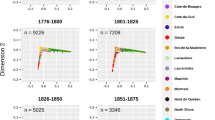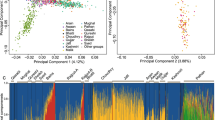Abstract
RECENT years have witnessed a rather rapid development of the population genetics of certain hereditary characters in man. Its findings are based mostly on the analyses of material obtained from voluntary blood donors1–3. This method of collecting research material has numerous advantages, but also several marked disadvantages. For example, data on the frequency of hereditary characters are mostly limited to the antigen properties of red blood cells2. The value of work in population genetics increases with the number of analysed genes from a certain population sample. Some of the genes being factors of marked polymorphism in man, their frequency can lead us to remote ancestors, and genes can serve as markers in the study of linkage in the chromosomes in man, where the need for just such markers is felt most acutely4.
This is a preview of subscription content, access via your institution
Access options
Subscribe to this journal
Receive 51 print issues and online access
$199.00 per year
only $3.90 per issue
Buy this article
- Purchase on Springer Link
- Instant access to full article PDF
Prices may be subject to local taxes which are calculated during checkout
Similar content being viewed by others
References
Boyd, W. C., Tabulae Biologicae, 17, 113 (1939).
Mourant, A. E., The Distribution of the Human Blood Groups (Blackwell Sci. Pub., Oxford, 1954).
Race, R. R., and Sanger, R., Blood Groups in Man, third ed. (Blackwell Sci. Pub., Oxford, 1958).
Allison, A. C., Amer. Nat., 93, 5 (1959).
Bhende, Y. M., Deshpande, C. K., Bhatia, H. M., Sanger, R., Race, R. R., Morgan, W. T. J., and Watkins, W. M., Lancet, i, 903 (1952).
Ceppellini, R., Nasso, S., and Tecilazich, F., La malattia Emolitica del Neonato (Istituto Sieroterapico, Milanese Serafino Belfanti, Milano, 1952).
Levine, P., Robinson, E., Celano, M., Briggs, O., and Falkinburg, L., Blood, 10, 1100 (1955).
McConnell, R. B. (personal communication, 1960).
Harris, H., and Kalmus, H., Ann. Eugen. (Lond.), 15, 24 (1949).
Smithies, O., Biochem. J., 71, 585 (1959).
Grünwald, P., Second Intern. Conf. Hum. Genet. (Abst.), Rome (1961).
Polak, A., Acta Med. Jug., 8, 177 (1954).
Pfeifer, S., and Lukovič, G., Rad. knj., 323, 225 (Jazu, Zagreb, 1961).
Baitsch, H., Liebrich, K. G., Pinkerton, F. J., and Marmond, L. E., Second Intern. Conf. Hum. Genet. (Abst.), Rome (1961).
Pfeifer, S., and Grünwald, P., II. Jug. simp. end. guš., 267 (Komnis, Zagreb, 1961).
Grünwald, P., and Herman, Č., Nature, 194, 95 (1962).
Grünwald, P., and Pfeifer, S., Lij. vj., 84, 27 (1962).
Sutton, H. E., Matson, G. A., Robinson, A. R., and Koucky, R. W., Amer. J. Hum. Genet., 12, 338 (1960).
Baitsch, H., Meier, G., Schoeller, L., and Kahlich-Koenner, D. M., Nature, 186, 976 (1960).
Murawski, K., and Miszcak, T., Science, 133, 1427 (1961).
Penrose, L. S., in Natural Selection in Human Population (Pergamon Press, London, 1959).
Author information
Authors and Affiliations
Rights and permissions
About this article
Cite this article
GRÜNWALD, P., HERMAN, Č. Study of Several Gene Frequencies in Yugoslav Population. Nature 199, 830–831 (1963). https://doi.org/10.1038/199830a0
Issue Date:
DOI: https://doi.org/10.1038/199830a0
Comments
By submitting a comment you agree to abide by our Terms and Community Guidelines. If you find something abusive or that does not comply with our terms or guidelines please flag it as inappropriate.



